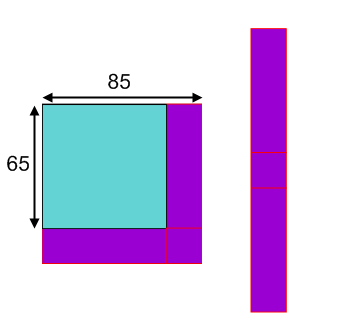Copyright © University of Cambridge. All rights reserved.
'Plus Minus' printed from https://nrich.maths.org/
Show menu
Why do this problem?
This problem offers students a chance to discover the identity for the difference of two square numbers. They are expected to work as research mathematicians, starting from simple examples, noticing patterns, developing conjectures and explanations that lead to proofs and further exploration.
It recognises the power of diagrams to help us make sense of algebraic generalisations.
Possible approach
This problem follows on from Hollow Squares and/or What's Possible?
Write these first two examples from the problem on the board:
$$65^2-35^2=3000$$
$$55^2-45^2=1000$$
Ask students to suggest other pairs of numbers where the difference of their squares is a multiple of $1000$. Write their suggestions on the board.
If they only offer pairs of numbers that add up to $100$, write up
$$85^2-65^2=3000$$
$$85^2-35^2=6000$$
"Do you notice anything special about these pairs of numbers?"
Encourage students to use anything they notice to generate some more examples.
"Mathematicians are always interested in explaining anything that they notice."
Share this diagram with the class:

The following questions address the key ideas that we want students to encounter. Allow students plenty of time to reflect on these questions, maybe working in pairs initially, and discuss answers as a class:
"What is the connection between this diagram and the calculation $85^2-65^2$?"
"How could we work out the area of the long purple rectangle (without a calculator)?"
"Can you draw similar diagrams for some of our other calculations?"
"How can these diagrams help us to develop a quick method for evaluating $a^2-b^2$ for any values of $a$ and $b$?"
Now introduce students to another set of interesting results:
$$89^2-12^2=7777$$
$$78^2-23^2=5555$$
Can students explain why the digits are repeated, using the insights they have gained earlier?
Can they generate some similar examples?
How about $555555$? $434343$? $505505$?
When appropriate, bring the class together to share and compare strategies.
Finally, set students the task of exploring possibilities for generating "interesting" numbers of their own, to present to the rest of the class at the end.
Possible questions that students might wish to consider:
Can you write $1000, 2000, 3000...$ as the difference of two square numbers?
Can you write any of them in more than one way?
Can you write any repeated-digit number as the difference of two square numbers?
What about numbers like $123321$, $123456$...?
Another exploration that might yield conjectures about differences between square numbers is to look at the areas of rings of different widths. This article explains one student's work on this.
Key questions
How does the diagram represent the difference between two square numbers?
Possible support
Pair Products is a good problem to introduce students to algebraic ways of representing general numerical results.Possible extension